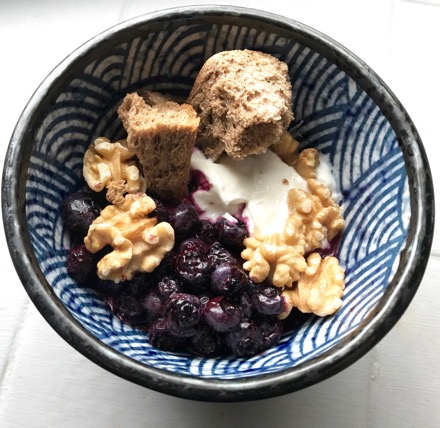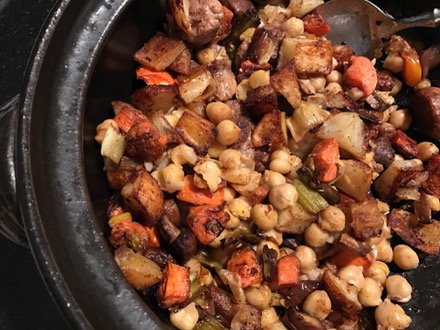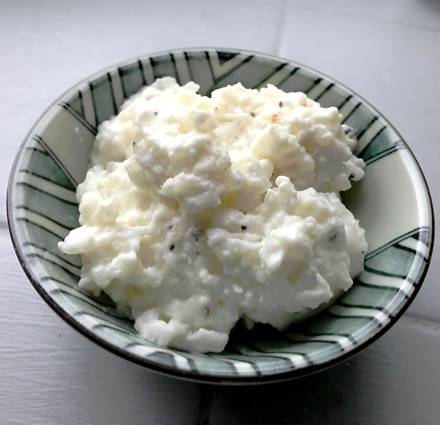You’ve heard it before that one of the healthy patterns of eating is the Mediterranean diet. But does that mean you need to abandon the use of local foods?
You’ve heard it before that one of the healthy patterns of eating is the Mediterranean diet. But does that mean abandoning local foods? Not at all!
Here’s what eating Mediterranean looks like in our house, courtesy of the Greek cook in our family.
Breakfast
Yogurt, berries, nuts and rusks
 We make our own yogurt, then strain it to make it nice and thick. Any milk you buy in BC is local, so of course, our yogurt is local. Topped with berries, frozen from BC’s summer harvest, walnuts and crumbled rye rusks (paximadia) makes for a pleasing and satisfying breakfast. Paximadia are simply twice baked bread. Thick slices are baked again to produce a dry rusk that stores well. Rusks can be made from wheat, barley or rye or a combination of the grains. We favor rye. Wheat/barley is a very common combination, however, as traditionally, many grain fields in Greece were sown in a combination of barley and wheat.
We make our own yogurt, then strain it to make it nice and thick. Any milk you buy in BC is local, so of course, our yogurt is local. Topped with berries, frozen from BC’s summer harvest, walnuts and crumbled rye rusks (paximadia) makes for a pleasing and satisfying breakfast. Paximadia are simply twice baked bread. Thick slices are baked again to produce a dry rusk that stores well. Rusks can be made from wheat, barley or rye or a combination of the grains. We favor rye. Wheat/barley is a very common combination, however, as traditionally, many grain fields in Greece were sown in a combination of barley and wheat.
Lunch
Chickpeas with veggies, feta and bread on the side
 Leftover chickpeas make for a hearty wintertime lunch. We boil up the bones leftover from a chicken meal to prepare the broth. But sometimes we don’t have broth, and I have to say, chickpeas are tasty enough cooked on their own. Sauté some onions in a pressure cooker, add water or broth, a few bay leaves and raw chickpeas. Yes, raw. You don’t have to presoak chickpeas when you pressure cook them. Pressure cook the chickpeas for about 30 minutes, then check for doneness. Depending on the chickpeas, this may be enough time; some chickpeas will need another 10 minutes or so. The pressure-cooked chickpeas become nice and creamy. While it’s pressure cooking, separately sauté some carrots, peppers, mushrooms, greens, whatever you want. When the chickpeas are done, add in the sautéed ingredients. With plenty of water or broth it’s soup, without, it’s a hot salad. The dish is even better the next day, warmed quickly in the microwave. Accompany the chickpeas with a thick slice of whole wheat bread and a slice of feta cheese on the table. A few spoonfuls of chickpeas, a bite of bread, break off a piece of feta…mmm.
Leftover chickpeas make for a hearty wintertime lunch. We boil up the bones leftover from a chicken meal to prepare the broth. But sometimes we don’t have broth, and I have to say, chickpeas are tasty enough cooked on their own. Sauté some onions in a pressure cooker, add water or broth, a few bay leaves and raw chickpeas. Yes, raw. You don’t have to presoak chickpeas when you pressure cook them. Pressure cook the chickpeas for about 30 minutes, then check for doneness. Depending on the chickpeas, this may be enough time; some chickpeas will need another 10 minutes or so. The pressure-cooked chickpeas become nice and creamy. While it’s pressure cooking, separately sauté some carrots, peppers, mushrooms, greens, whatever you want. When the chickpeas are done, add in the sautéed ingredients. With plenty of water or broth it’s soup, without, it’s a hot salad. The dish is even better the next day, warmed quickly in the microwave. Accompany the chickpeas with a thick slice of whole wheat bread and a slice of feta cheese on the table. A few spoonfuls of chickpeas, a bite of bread, break off a piece of feta…mmm.
What’s local here? Well, the chickpeas won’t be from BC, but they are Canadian. Saskatchewan is a significant grower of chickpeas. and there are many suppliers of Canadian feta cheese, including from BC. The bay leaves come from the formidable shrub in a neighbor’s yard. Bread, of course, is plentiful locally, and we often just make it at home.
Dinner
Fish and greens
Wild greens grace the dinner table with frequency in Greece. Known collectively as horta, there are many varieties that are gathered in the mountains and sold door-to-door, even in big cities like Athens. Many are the conversations among Greeks about which are their favourites.
Vlita (amaranth greens) is often a leader, but radiki (dandelion greens) is always a strong contender. Here in Vancouver, we take a trip to the backyard and pick the dandelion greens that we allow to grow with abandon in one corner of our vegetable garden. The greens are boiled, drained, then dressed with plenty of olive oil, lemon and salt and pepper. The olive oil and lemon are the Mediterranean elements we keep. Canola oil would be a good substitute for olive oil, and more local, but we have a strong preference for the taste of olive oil, so we make this exception. Lemon is a perfect pairing for the bitterness of the greens, a taste sensation! (Learn more about how to appreciate the bitter flavor from the cookbook, Bitter.) Dandelion greens are available in some large supermarkets too, but we find that the taste is much blander compared to what we grow in the backyard. If you aren’t used to the bitterness of wild dandelion greens, you may prefer the cultivated variety offered in supermarkets.
Fish from our local market that specializes in locally caught fish (today it’s ling cod) is pan-fried, also using olive oil. Again, it is dressed with salt and pepper and plenty of lemon.
We serve this meal with more lemon at the table, so we can give a fresh squeeze just before we eat to add even more brightness to the food. The meal is completed with some crusty, fresh whole wheat bread to sop up all the lemony olive oil juices left on the plate.
 Finish the meal with a rice pudding. We favor one made with rose water and plenty of cardamom, but a vanilla and cinnamon flavoured rice pudding is delicious too. Rizogalo, the Greek word for rice pudding, is a compound word (rice-milk) that reveals the two main ingredients. Our recipe starts with ½ cup of short grain rice and 4 cups of milk. It’s only sweetened with ¼ cup of sugar, as much sweetness is imparted by the milk as it cooks down and caramelizes.
Finish the meal with a rice pudding. We favor one made with rose water and plenty of cardamom, but a vanilla and cinnamon flavoured rice pudding is delicious too. Rizogalo, the Greek word for rice pudding, is a compound word (rice-milk) that reveals the two main ingredients. Our recipe starts with ½ cup of short grain rice and 4 cups of milk. It’s only sweetened with ¼ cup of sugar, as much sweetness is imparted by the milk as it cooks down and caramelizes.
So there you have it. A day with the Mediterranean diet. The key components of a healthy pattern of eating are all there: vegetables, fruit, whole grains, legumes, fish, olive oil, nuts and dairy. A little wine with dinner might have been nice too!



